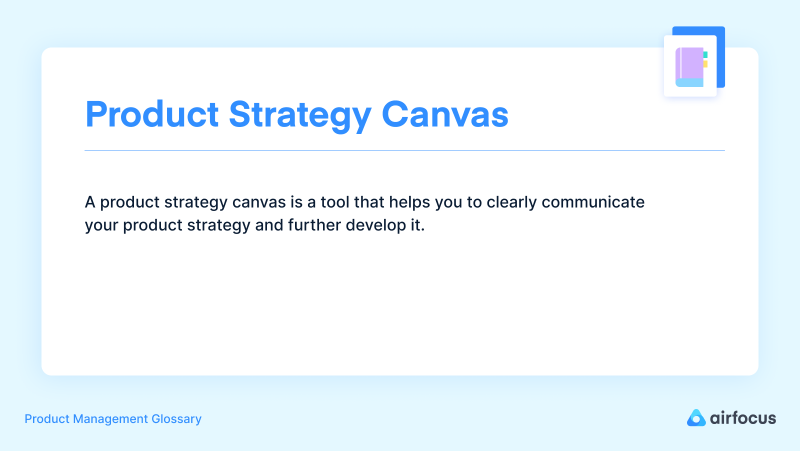Product Strategy Canvas
What is the product strategy canvas?
Product Strategy Canvas
A product strategy canvas is a tool that helps you to clearly communicate your product strategy and further develop it.
Product consultant Melissa Perri created the product strategy canvas. She aimed to create a tool that would differentiate a plan from a strategy.
After seeing many product strategies fail, Perri recognized that many businesses were framing their product strategy incorrectly. They would describe the plan for the product rather than the strategy behind it. This is an issue for businesses because their plan doesn’t acknowledge how they will enact it.
A product strategy should describe a system of achievable goals and visions that will work together to align the team around key outcomes for both the business and its customers. You can include KPIs, OKRs, and other metrics to gauge how the strategy is performing, but they cannot create a successful strategy on their own.
Product strategy vs. Product business model canvas
These two tools are similar but focus on entirely different business areas. As the names suggest, a product strategy canvas will focus on a singular product, while a product business model canvas will focus on the overall business.
What are the differences?
A business model canvas is a one-page summary describing the high-level strategic details needed to successfully bring a business to market. The specifics of this canvas will change depending on what the business does, but most will cover at least the following:
Customer segments
Key activities
Key resources
Customer relationships
Key partners
Cost structure
Revenue streams
The canvas will visualize a comprehensive set of building blocks you’ll need to consider before launching the business. There will undoubtedly be additional factors that come into play, but the canvas helps you focus on high-level details early in the cycle.
While the business strategy canvas can include products, a product strategy canvas focuses specifically on a singular product. The product strategy canvas allows us to think deeper about our product strategy. It should contain the following:
Vision: The highest-level view of where your product and business are heading.
Challenge: The business goal you want to focus on to reach the product vision.
Target Condition: The challenge is broken down into manageable pieces that can be solved to help reach the vision.
Current State: The current baseline compared to the target condition.
Following this framework allows teams to gain a holistic view of the product and how it relates to current business goals.
Product strategy canvas examples
The product strategy canvas is a simple tool that anyone can use and clearly understand. For the sake of this example, let’s use airfocus and say our overall goal is to become the top choice for product managers worldwide. Our product strategy canvas will look something like this: Vision: In five years, airfocus will be the top platform for product managers everywhere.
Challenge: To reach our vision, we need to develop more customer-requested features by 2027.
Target condition: We first need to build the most requested feature to reach our challenge.
Current state: After measuring, we know that our current state is a feature-rich platform, lacking customer-requested features.
How airfocus can help with product strategy canvas
Airfocus has many tools to help product managers with their product strategy canvas. You can use airfocus to roadmap your challenges, allowing teams to quickly understand what is required to achieve the overall product vision.
Our extensive range of prioritization tools — including our free-to-use Priority Poker — will help identify your business needs and enable confident, effective decision-making. The airfocus platform can also help with stakeholder management while you prepare your product strategy canvas.

General FAQ

Glossary categories
Create effective product strategy

Experience the new way of doing product management








